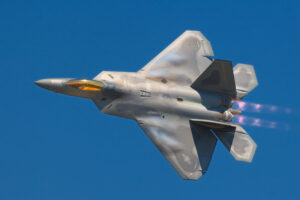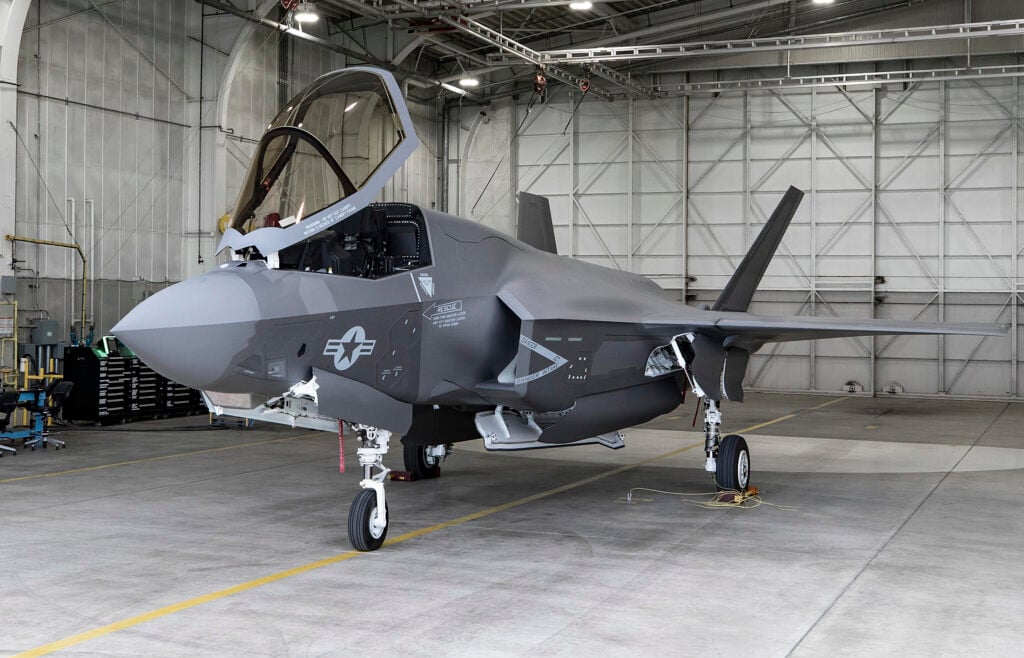
CV-22 formation
WASHINGTON: Jumping off lessons learned in the ‘Mad Hatter’ effort to help fix the F-35’s infamous ALIS system, the Air Force’s Kessel Run software ‘factory’ now is working to improve maintenance tools for the F-22 stealth jet and the CV-22 Special Operations tiltrotor.
“Kessel Run is not replacing ALIS, but providing applications to make maintainers’ lives easier, making schedule maintenance easier and scheduling flying all in one suite of tools,” Hannah Hunt, Kessel Run chief of staff, told me in an email. “The Mad Hatter Effort is now known as Torque, as we are working towards improving maintenance scheduling tools for other aircraft such as F-22 and CV-22.”

F-22 Raptor
Sure, “maintenance scheduling tools” don’t sound as sexy as zooming through the air — but you’re not zooming anywhere if your ride is broke. Reducing the time groundcrews spend keeping track of maintenance schedules, spare parts deliveries, and reports means more time actually fixing things, which means more aircraft that actually work. That’s all critical to bolstering readiness levels and reducing exorbitant sustainment costs.
That task was a major reason Kessel Run stood up in 2018 as a unit (Detachment 12) underneath Air Force Life Cycle Management Center. One of its first tasks to wrestle down ALIS from a giant time-sink and turn it into a system that actually helps ground crews do their jobs.
Indeed, Air Force acquisition czar Will Roper sees Kessel Run’s success with supporting the overhaul of the F-35’s logistics software as not just critical to the program, but also as a model for all future Air Force programs.
“Kessel Run provides amazing software expertise, not just coding, but providing worldwide infrastructure, a help desk, all the functions you need to be a good, quote, ‘software company’ — and the government hasn’t been a good software company, which is why so many programs have been troubled,” Roper said last week.
Kessel Run’s support has made it possible for the F-35 Joint Program Office, led by Gen. Eric Fick, not only to better oversee prime contractor Lockheed Martin’s effort to replace ALIS with a new system, but also to take a role as a provider of the software design itself, Roper told reporters on July 14.
“I’m very delighted that Kessel Run is helping the F-35 program, because F-35 is such a big deal to the Air Force given the number that we’re going to own and operate,” he said. “But the key to keeping the sustainment costs down is being able to work the worldwide logistics supply chain seamlessly as a software problem.”
The Air Force on July 13 announced that it has granted Lockheed Martin an $87.5 million indefinite-delivery/indefinite-quantity (ID/IQ) contract for “non-recurring engineering for the development and maturation of the Autonomic Logistics Information System (ALIS) in support of data migration and transition to the newly developed F-35 Operational Integrated Data Network (ODIN).” The contract also covers “software and hardware engineering in support of F-35 ODIN development, delivery and associated data management activities.”

F-35
ODIN is being developed as a cloud-based system that will allow the services to do their own software upgrades to the F-35, rather than be tied to Lockheed Martin-provided solutions. DoD’s 2021 budget request for ALIS equipment was $59.4 million across all variants of the F–35 — a request that the House Appropriations Committee begrudgingly granted on July 14, noting continuing trepidation about the transition from ALIS to ODIN.
But as critical a mission as it is, streamlining maintenance isn’t Kessel Run’s only — or even primary — job.
“Through Air Combat Command, our main focus is the modernization of the Air Operation Center Weapon System — there’s about two dozen sites around the world — that basically plan the air war,” Nick Setterberg, the outgoing lab director, told me in an interview earlier this month.
The Air Operations Centers — such as the 609th AOC at Al Udeid Air Base in Qatar — are responsible for gathering intelligence and surveillance data on potential targets, allocating the resources to carry out strikes, and then hitting those targets. Kessel Run’s goal is to speed that cycle. This includes supporting DoD’s high-priority Joint All-Domain Command and Control System (JADC2) being designed to run future all-domain warfare.
Kessel Run thus is working very closely with Air Force Chief Architect Preston Dunlap in developing software tools under the Advanced Battle Management System program that the service sees as the technological backbone for JADC2.

ABMS construct
“Operational-level C2 certainly plays a large role in the future ABMS & JADC2 vision — with Air Operations Centers at the heart of it. We have a goal to provide an end-to-end ecosystem, utilizing modern cloud technologies, to enable a mesh, distributed Command and Control network that will allow us to leapfrog from the current state of the art to an inherently flexible and dynamic system that adapts faster than our adversaries can keep up with. Warfighting commanders should be able to call for effects from every domain as easy as they can hail a cab,” Hunt said in an email.
“In JADC2 parlance, this is the idea of a ‘Dynamic Tasking Order,’ at Kessel Run we call this grand vision ‘Continuous Airpower’. In order to realize that vision, we need to wean ourselves from the AOC’s reliance on physical humans and physical hardware in brick and mortar buildings,” she added.
Kessel Run is working alongside the Kobayashi Maru, Space Camp and Platform One teams — all of which are software development units based on the Kessel Run model — on a range of problems related to ABMS requirements. Several Kessel Run leaders, including Commander Col. Brian Beachkofski, are providing support for development of a number of the seven ABMS “Categories” and 28-odd “Product Lines.”
For example, Andrew Kemendo, Kessel Run’s chief data officer, has been serving as the co-lead for the Data Category, which includes such products as the dataONE library for storing data. (He is now being replaced by Jacque Torson.)
Further, while Kessel Run is best known for its software development work, its mission includes a mandate to both speed and improve the processes by which the service acquires software. Indeed, Kessel Run’s very name — after Han Solo’s famous boast about the speed and efficiency of the Millennium Falcon in traversing a dangerous smuggler’s route in the first Star Wars movie — was aimed to convey that mission.
“This was the original intent of KR — to become a hybrid acquisitions and operations unit that delivers war-winning software capabilities faster and at better value than has ever been done before,” spokesperson Bruce Katz said in an email.
“The DoD owns this designer, manufacturer, tester, maintainer and services provider of the vital tools needed to increase its warfighting abilities and lethality. It is creating software and delivering products to end-users quicker, with better features, design and needs-satisfaction than can be sourced outside the military and is being done with better cost-efficiencies. That is KR’s real value!” he added.

Kessel Run coders in action
Setterberg, for his part, believes that another important mission for Kessel Run is simply providing an example for the rest of the Air Force — both for how to innovate and encourage new ideas, but also how to better link acquisition efforts and the user community.
“It’s really important in our process to validate what we’re building with people who are actually in the field,” he said. “I like to use this framework: we have our ‘big’ requirements from Air Combat Command, but then in practice as we go and explore these problem spaces and build software to solve problems, we embrace user-centered design, get direct feedback from our users, and build to the ‘small’ requirements … developed from doing ethnography and user research and understanding the environment that the warfighters are operating in. We strive every day to create a learning culture through a powerful combination of high psychological awareness and high accountability.”
Finally, Setterberg said, one of the keys to Kessel Run’s success has been its culture.
“In day-to-day operations, one of our four core values at Kessel Run is ‘ideas over rank.’ So, regardless of employment status, we’re making decisions together in support of our users,” he said.
In a ‘world first,’ DARPA project demonstrates AI dogfighting in real jet
“The potential for machine learning in aviation, whether military or civil, is enormous,” said Air Force Col. James Valpiani. “And these fundamental questions of how do we do it, how do we do it safely, how do we train them, are the questions that we are trying to get after.”


























